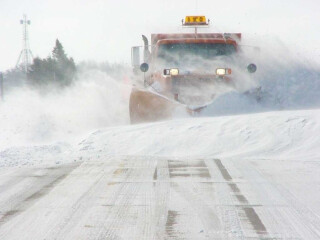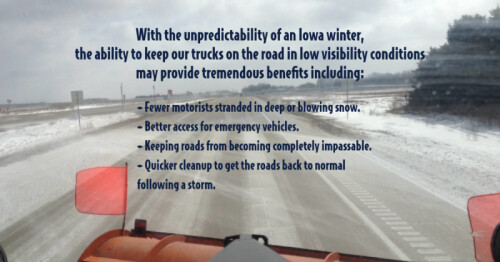Even in the worst winter storms, some travelers may not be able to stay put and wait for the weather to improve. Because safety is at the core of everything we do at the Iowa Department of Transportation, our advice will always be to sit tight if the conditions are bad enough that it is dangerous for you to be driving. But if you must travel, we’ll be there for you, using the latest technology to safely clear the roads.

Although we like to think our snow fighters have superpowers, they can’t see any better through the windshield of a snowplow than you can through your windshield. However, a research project being conducted in our Tama garage is looking at using technology to “see” through the worst winter weather, allowing our operators to make safer and better informed decisions when plowing snow.
We first told you about this research project last November. Working with Iowa State University’s Institute for Transportation, we’ve equipped a snowplow with sensors and driver aids to allow our staff to continue working in low-visibility situations.
This technology doesn’t take over any control from the operator, but is designed to display critical information about where the plow is on the road and what obstacles may lie ahead.
Jason Fisher from our Maintenance Bureau said, “When the visibility is low and it’s not safe for our operators to be out clearing snow, the snow piles up and it takes longer to get the roads open and get traffic moving again. If we can find a way to safely keep our plows on the road, even in low visibility conditions, that would make it possible to get the roads back in good shape quicker, helping travelers get where they need to go.”
But travelers aren’t the only concern when bad weather makes the roads treacherous. “When a bad storm is raging, emergency responders rely on us more than ever to keep the road passable so they can get to people who need assistance,” said Tina Greenfield from our Maintenance Bureau. “If we can keep our trucks on the road, we can better assist the emergency crews out there doing what they need to do.”

Greenfield said, “Early last winter Iowa State came out and mounted sensors to the plow truck that feeds information to equipment in the cab. That equipment processes the data and displays it on a tablet for the operator to see.”

Rusty Martin, the garage operations assistant in Tama who wrote the initial proposal for the research project several years ago, says, there are two parts to the research which is currently in “demonstration mode.”
- A navigation piece that uses the data to know where you’re going.
- An object-avoidance piece that uses the data to know what’s ahead of you.
Over the past year, the truck equipped with the sensors has been collecting data, in all types of weather and while the operator is performing a variety of tasks. He said, “The system uses GPS, much like is used in the ag industry. The technology has come a long way in the past few years and I think it’s going to prove to be very valuable.”
Martin continued, “During the planning stages, we looked for technologies that would do what we need them to do and were cost-effective. Once we identified the technology and installed it last year, there has been a lot of tweaking. The test equipment we have set up is pretty simple and we’ll continue to collect data during this winter season.”

Greenfield explained, “Using the data collected over the last year, we’ve determined the navigation piece is working pretty well. During winter operations our trucks need to ride over the centerline to uncover that paint line for travelers to see. The sensors are providing feedback on where the truck is situated on the road. This data is displayed for the operator inside the cab, but it is also collected and used to train an algorithm for that particular segment of road.”
“When you’re clearing a road in a storm, keeping track of the paint lines is the key,” said Martin. “If you lose the paint lines, you have no idea where you are on the road. When we’re the first on a snow-covered road, it can be very difficult to visually see the paint lines. Training this equipment to ‘see’ the paint lines for the operator will make us clear the roads more effectively.”

Next steps
All those involved in this project say they’re excited to continue to refine the navigation piece, but they are anxious to begin refining part of the system that will help operators avoid obstacles on the road.
“When we can’t see what’s underneath the snow on the road ahead, the situation is dangerous for everyone,” said Martin.
While the team continues to hone the navigation piece of this research project, they will also be tweaking the sensors that detect obstacles hidden by snow. Martin says this phase of the project is proving to be a little trickier. “What we are looking at would be something like the blind-spot alert system you might have in your personal vehicle. We are testing how well the system can detect stalled vehicles and other obstructions on the road. We’re not there yet, but I’m confident we’ll get there.”
This research project is just one of many conducted with the help of our university partners, as well as projects undertaken in coordination with other states. Look for updates on Iowa DOT research in upcoming blog posts.
Editor’s note: This post is part of a series related to our 5-year priority goal of “Supporting a Culture of Innovation” at the Iowa Department of Transportation. We are working to find innovative ways to improve processes, tools, & relationships to create positive experiences for our customers.